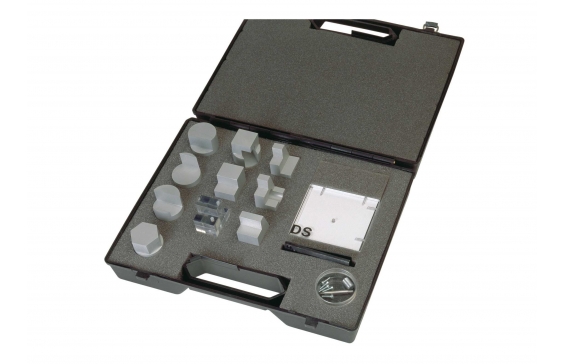TZ 100 Engineering drawing: three-dimensional display

In order to describe a spatial body adequately and thereby fulfil a basic principle of exact replication and repeatable production, several views of the body are usually necessary. To do this, bodies are shown in three planes: front view, side view and plan or bottom view. The presentation follows fixed rules that are defined in the standards. Even for simple bodies, the presentation in three planes requires a considerable degree of abstraction ability and spatial imagination on the part of students. This ability is a prerequisite for both creating and interpreting engineering drawings or sketches and is taught by means of geometric models.
The TZ 100 model set provides a learning concept with which to introduce students to the discipline of descriptive geometry.
A corner of a room, comprising three flat Plexiglas sheets, holds the models. The corresponding view is inserted into each plane of the room corner, so that it is possible to directly compare model (workpiece) and drawing.
A total of ten models of varying difficulty are included. One model is made of Plexiglas in order to develop an understanding of hidden edges. The other models are made of aluminium.
The models are precision-manufactured so that measuring exercises can also be conducted. All parts are clearly laid out and well protected in a storage system.
The exercises are ideally performed by the students themselves. Two students can comfortably work with one model set.
The instructional materials include a complete set of drawings. A representation in three views, the 3D view and the production drawing are included for each model.
- GUNT course: engineering drawing
- model set for developing spatial concepts
- fundamentals of three-dimensional display
5 prismatic models
- LxWxH: 40x30x50mm
4 cylindrical models
- ØxH: 40x50mm
1 transparent model
- LxWxH: 40x30x50mm
3 Plexiglas planes
- LxWxH: 100x100x100mm
- set of models from the descriptive geometry discipline to develop spatial concepts
- introduction to engineering drawing
- precision manufacture of the models allows measuring exercises
- room corner comprising three Plexiglas planes
- 9 aluminium geometric models; cylindrical and prismatic shapes
- 1 Plexiglas model
- storage system for parts
- familiarisation with three-dimensional display as a basic principle of engineering drawing
- step-by-step development of spatial thinking: from the concrete situation to the abstract representation in an engineering drawing
- measuring exercises
